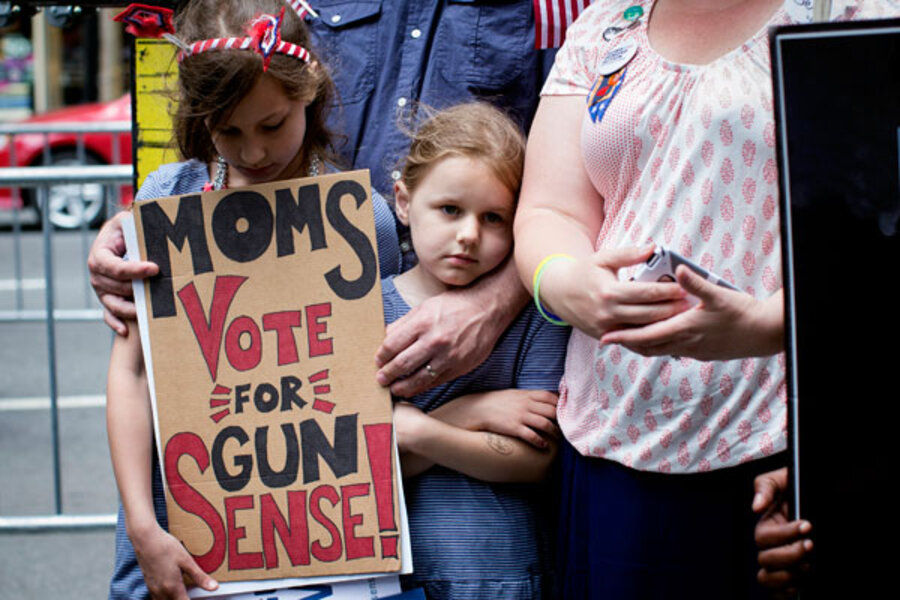How Bloomberg's gun control group stacks up against NRA
| Washington
Michael Bloomberg and his gun-control group are taking aim at this fall’s midterm elections.
On Monday, former New York Mayor Bloomberg's Everytown for Gun Safety unveiled a 10-point questionnaire that asks Senate and House candidates where they stand on various gun-safety measures, such as expanding background checks and limiting the size of ammunition magazines. Like the powerful National Rifle Association (NRA), Bloomberg wants to use the questionnaire to mobilize voters.
It is a sign that Everytown for Gun Safety wants to match and eventually surpass the NRA’s extraordinary political influence. But can it? Here’s how Everytown stacks up against the NRA in two key ways.
Money. Bloomberg, a billionaire, has pledged $50 million of his own money to Everytown. The NRA spent nearly $20 million to influence the 2012 elections. Bloomberg’s personal wealth gives Everytown a huge advantage here.
Of course, the NRA isn’t the only pro-gun group spending money, but then again, Everytown is not the only gun-control group either. Former Rep. Gabrielle Giffords (D) of Arizona and her astronaut husband, Mark Kelly, formed the super political action committee Americans for Responsible Solutions after she was severely injured in the Tucson, Ariz., shooting that killed six people in 2011. The super PAC has raised nearly $15 million so far and is aiming for $20 million for this election cycle.
Mobilization. Money isn’t everything. “Money can’t buy the hearts and minds of the American people when it comes to the Second Amendment,” NRA spokesman Andrew Arulanandam told The Washington Post.
He’s right. The NRA’s real strength is its ability to mobilize voters – to get them off of their couches and to the phones, to meetings and rallies, to letter writing and e-mailing, to leafleting, and to the voting booth. While 90 percent of Americans may support expanding background checks to the Internet and gun shows, getting them to act is something else entirely.
Everytown, which is the umbrella group for Mayors Against Illegal Guns and Moms Demand Action for Gun Sense in America, is at a distinct disadvantage here. It claims more than 2 million followers, while the NRA has 5 million dues-paying members. Add to that its decades of lobbying experience on Capitol Hill and in statehouses.
Still, Everytown is hoping to close the gap with an aggressive social media campaign. Unlike the NRA, Everytown is making its questionnaire available to the public to take and share with others. It has turned to Mitch Stewart, President Obama’s former campaign director for battleground states, as a consultant on a data-driven strategy.
“What's important here is mobilizing the power of Americans,” says Stacey Radnor, Everytown’s director of communications.
The group has some successes to point to. Moms Demand Action’s social media campaign has pressured businesses such as Target, Chipotle, and Starbucks to keep guns out of their stores, even in states that allow “open carry.” This year, Everytown and Moms Demand Action have helped pass bipartisan gun legislation in six states to prevent domestic abusers from getting guns.
Still, don’t expect this effort to have much if any effect on elections this fall, says Robert Spitzer, author of “The Politics of Gun Control.” The ability of a single issue to actually change an election is “pretty limited,” he says.
“Most Americans don’t vote on the gun issue,” and despite the NRA’s reputation, the number of races where it has made a difference is “vanishingly small,” says the political scientist at the State University of New York, Cortland.
What’s significant about Everytown’s announcement on Monday is what it may signal for the long term, he says. Will it be just as committed in 2016, in 2018, in 2020?
Everytown leaders say yes, and the trend lines are on their side, according to the General Social Survey by NORC, a research center at the University of Chicago. A New York Times analysis of the survey data shows the share of American households that have guns declining from 50 percent in the 1970s to 34 percent today, though the NRA contests the figures.
"Demographics work against gun ownership," says Professor Spitzer.







